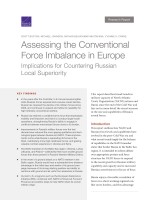| 来源类型 | Research Reports
|
| 规范类型 | 报告
|
| DOI | https://doi.org/10.7249/RR2402
|
| 来源ID | RR-2402
|
| Assessing the Conventional Force Imbalance in Europe: Implications for Countering Russian Local Superiority |
| Scott Boston; Michael Johnson; Nathan Beauchamp-Mustafaga; Yvonne K. Crane
|
| 发表日期 | 2018
|
| 出版年 | 2018
|
| 页码 | 16
|
| 语种 | 英语
|
| 结论 |
Current Imbalance of Military Power on the Russian Border a Result of Different Motivations- In the years following the end of the Cold War, NATO's ground forces have substantially declined in size and shifted focus away from high-intensity conventional combat.
- By contrast, while Russia also saw a major decline through the 1990s and 2000s, more-recent efforts have led to effective changes in Russian warfighting capabilities and a gradual spread of more-modern systems to much of the Russian armed forces.
- Recent improvements to readiness and to the ability to move forces quickly within Russia, combined with the density of anti-access/area denial capabilities arrayed to defend the Russian heartland, provide Moscow with a much greater ability to project force against countries on its borders.
The Russian Threat to NATO in the Baltics- While NATO militaries have retooled to focus on stability operations and lighter forces that can be more easily deployed out of area to such places as Afghanistan, Russia has retained a combined-arms force that emphasizes mobility and firepower and trains to conduct larger-scale combined-arms operations. This gives Russian forces an important advantage in conflicts between mechanized forces close to their border.
- There has been a notable increase in the quality of Russian forces over the last decade: a growing number of volunteer soldiers, fielding of modernized weapons, improvements to readiness, and experience gained from large-scale exercises and combat operations in Ukraine and Syria.
- The highest density of Russia's most-capable ground and air forces is in its Western Military District, which borders the NATO allies in Estonia, Latvia, and Lithuania, which have very small conventional forces.
- Russia's demonstrated ability to mass ready forces from elsewhere within its borders, leveraging its internal rail and road networks, means it is likely to enjoy a significant time-distance advantage in generating combat forces during the opening period of a crisis.
|
| 摘要 |
- Nothing about this analysis should suggest that Russian conventional aggression against NATO is likely to take place; however, prudence suggests that steps should be taken to mitigate potential areas of vulnerability in the interest of ensuring a stable security relationship between all NATO members and Russia.
- NATO has sufficient resources, personnel, and equipment to enhance conventional deterrence focused on Russia; a more robust posture designed to considerably raise the cost of military adventurism against one or more NATO member states is worthy of consideration.
|
| 主题 | Estonia
; Latvia
; Lithuania
; Military Strategy
; North Atlantic Treaty Organization
; Russia
; Threat Assessment
|
| URL | https://www.rand.org/pubs/research_reports/RR2402.html
|
| 来源智库 | RAND Corporation (United States)
|
| 引用统计 |
|
| 资源类型 | 智库出版物
|
| 条目标识符 | http://119.78.100.153/handle/2XGU8XDN/108722
|
推荐引用方式
GB/T 7714 |
Scott Boston,Michael Johnson,Nathan Beauchamp-Mustafaga,et al. Assessing the Conventional Force Imbalance in Europe: Implications for Countering Russian Local Superiority. 2018.
|
|
文件名:
|
x1517841733588.jpg
|
|
格式:
|
JPEG
|

|
文件名:
|
RAND_RR2402.pdf
|
|
格式:
|
Adobe PDF
|
除非特别说明,本系统中所有内容都受版权保护,并保留所有权利。